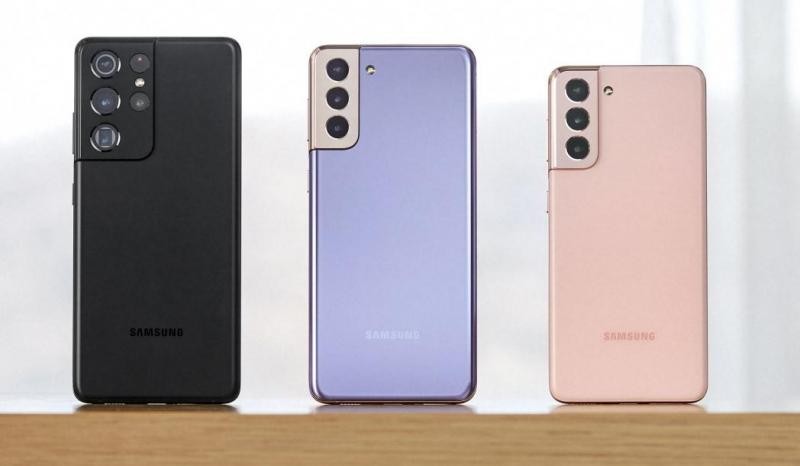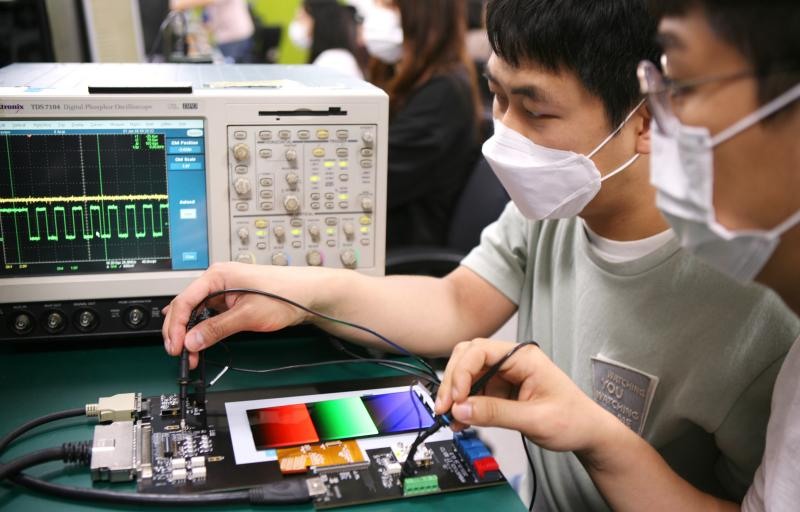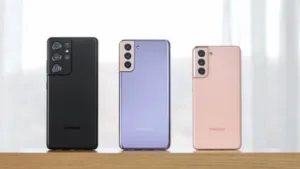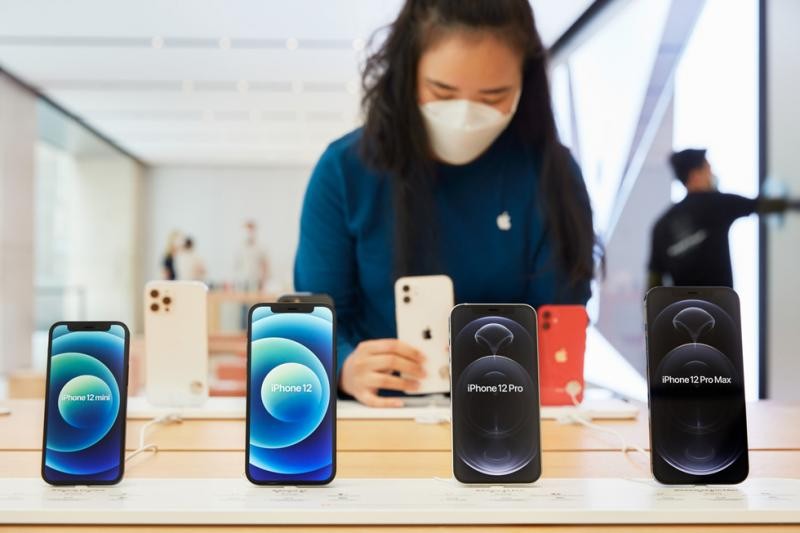The smartphone market has slowed down considerably in recent years. It was expected to recover in 2020 with 5G product introductions but the pandemic impacted both supply and demand side in the first half of the year. Smartphone shipments returned to positive growth in 4Q20 with the Apple iPhone 12(5G) introduction and its record performance.
Samsung has also introduced Galaxy 21 series with 5G capabilities and lower pricing than its previous series in January this year. The market is expected to recover with positive growth in 2021. Smartphones with 5G capabilities need slimmer, lighter, lower power consumption displays to accommodate 5G enabling components. Evolving flexible OLED display with new materials, breakthrough technology, higher integrations and lower power consumption can drive the next generation’s smartphones with better features and functionality.
According to an IDC press release in January 2021, global smartphone shipments returned to positive growth in the fourth quarter driven by record performance by Apple.
“While the full year 2020 declined 5.9% compared to 2019, the progress toward market recovery has been impressive and IDC believes the momentum heading into 2021 will remain strong. There are a lot of elements at play that are fueling the smartphone market recovery-pent-up demand, continued supply push on 5G, aggressive promotions, and the popularity of low to mid-priced phones.”
IDC also noted that Apple returned to number 1 position in 4Q20 with 23.4% market share and Samsung moved to number 2 with 19.1% market share. All the products in Apple’s iPhone 12 series use flexible OLED displays. Samsung and Apple are driving flexible OLED demand and technology developments. Most brands are adopting flexible OLED for their high-end 5G flagship products. The need for affordable 5G products at less than $400 or even less than $300 is leading suppliers to use LTPS LCD at lower cost levels.
Gaining Share in 5G
DSCC published data in November 2020 that showed;
“5G accounted for 60% of Q3’20 AMOLED smartphone panels in Q3’20, up from 40% in Q2’20, and will rise in Q4’20 to over 70% on Apple’s iPhone 12 launch”.
Premium 5G products are supporting demand for flexible OLED displays especially with Apple’s iPhones and Samsung’s Galaxy products. Other brands such as Huawei, Oppo, and Vivo are also offering flexible OLEDs for their premium 5G products. The introduction of 5G-based products needing slimmer displays to accommodate 5G enabling components will increase flexible OLED demand.
Gaining Share in Smartphone
Data published from Omdia in January 2021, said
“smartphone display shipment is expected to be 2 percent down YoY in 2020 but flexible OLED displays are up 8 percent.”
Flexible OLED will continue to gain share in smartphone market in 2021. Samsung Display dominates the flexible OLED market but LGD and BOE are increasing production. More capacity came from companies such as Tianma, Visionox, China Star (CSOT) and others in 2020. Chinese OLED makers’ production grew substantially in 2020 with improvement in flexible OLED yield rates and customers adoption.
Samsung Display continues to be dominant in terms of OLED capacity, shipments, price, performance and technology roadmap. China suppliers are starting to gain share with more capacity investments. By 2022, there will be nine Gen6 flexible OLED fabs in China. Higher competition can help to reduce costs and improve adoption rates in future. Suppliers are hoping to gain share in mid-range products in 2021.
Reducing Power Consumption
Display with lower power consumption capability can significantly reduce overall power consumption for smartphones enabling increased battery life. Samsung Display is focusing on LTPO (Low-temperature polycrystalline oxide) technology (combination of LTPS + Oxide TFT) that enables variable refresh rates and lower power consumption. Many other companies are also working on this technology for next generation displays. Apple is expected to use LTPO in its future products in 2021. (and we have a Display Daily planned on this topic – editor)
The Galaxy S21 Ultra is already using Samsung Display’s LTPO-based flexible OLED panel. Samsung Display recently announced that it has developed an organic material whose luminous efficiency has improved dramatically by having electrons flow faster and more easily across the display’s organic layers. The new low-power OLED display for smartphone can reduce power consumption by up to 16% compared to previous panels. Due to the new process, the OLED panel can create brighter light while consuming less powers. The new panel is being used for the first time in the Galaxy S21 Ultra.
 Samsung’s S21 comes as Ultra, and Plus as well as the standard S21
Samsung’s S21 comes as Ultra, and Plus as well as the standard S21
Increasing Sunlight Visibility
Samsung Display also announced that its newest OLED display has been recognized by UL (the global independent safety science company) for its “Sunlight Visibility” performance. UL assessed the color gamut and luminance of the new display, both of which can impact outdoor visibility. Samsung’s new OLED panel achieved an “Ambient Color Gamut” rating of 73% of the DCI (Digital Cinema Initiatives)-P3 level and a peak brightness of more than 1500 nits. The organic material is helping to achieve significantly improved outdoor visibility.
Samsung display noted in its press release that its new sunlight-friendly display’s visibility benefits would be combined with its recently announced technology allowing for significant reductions in OLED power consumption. Samsung Display’s newest OLED panel is available for other smartphone manufacturers. The Samsung Galaxy S21 Ultra 5G smartphone includes a 6.8-inch Dynamic AMOLED 2X display with variable refresh rates ranging from 10Hz to 120Hz that adjusts to the content viewing giving it better image quality while staying power-efficient. Compared with the Galaxy S20, the S21 Ultra offers a 25% brighter picture (1500 vs 1200 nits peak brightness).
 Engineers from Samsung Display are using testing devices to inspect frequency changes in display panels that feature adaptive frequency technology. Click for higher resolution
Engineers from Samsung Display are using testing devices to inspect frequency changes in display panels that feature adaptive frequency technology. Click for higher resolution
Increasing Integration
Samsung Display has also developed on-cell touch Y-OCTA (Youm On-Cell Touch AMOLED) for flexible OLED technology. (So What is Y-OCTA?) In this process, the touch sensor is deposited directly on the thin film encapsulation (TFE) layer enabling thinner flexible OLED displays. Optical features also improve as the touch layer is below the polarizer allowing the use of non-ITO materials for the transparent conductive film. This structure has fewer layers compared to add-on type. Samsung has used this process in its Galaxy products for some time. Now Apple has started using it in Apple iPhone 12. LG Display, BOE, Tianma, and Visionox are all developing their own processes for on cell touch integration to reduce the layers and increase performance.
Evolving Form Factors
Flexible OLED form factors are shifting from foldable to rollable and scrollable. As announced at CES 2021, TCL CSOT launched a 6.7-inch rollable AMOLED display that can be extended to 7.8-inch size, turning it from smartphone to tablet. LG Electronics also received industry attention by showing a rollable screen that can roll from a smartphone to tablet.
According to DSCC data published in December 2020,
“Foldable panel shipments are expected to rise 454% in 2020 to 3.1M units in 2020. Samsung is clearly the dominant brand in 2020 with over a 90% share in Q3’20 and Q4’20 on a panel procurement basis and 87% share for the year.”
The DSCC publication also said,
“120Hz refresh rates led for the first time in Q3’20 as did LTPO backplanes. Also 5G accounted for a majority of foldable devices for the first time in Q3’20”.
With both larger display sizes and 5G, power consumption increases, if all other things are equal. LTPO with its capability of variable refresh rates can be used to reduce power consumption. DSCC forecast that in smartphones, foldables are expected to grow at an 80% CAGR to 59M panels with rollables growing at a 121% CAGR to 24M panels.
The introduction of 5G-based products needing slimmer displays to accommodate 5G enabling components will increase flexible OLED demand. Integration of new technology such as fingerprint under display, touch display, power savings, variable refresh rates, and other features to reduce border & increased screen-to-body-ratio can make flexible OLED more critical for next generation products. (SD)
Sweta Dash is the founding president of Dash-Insights, a market research and consulting company specializing in the display industry. For more information, contact [email protected] or visit www.dash-insights.com


